Tires MERCEDES-BENZ GLK-Class 2013 X204 Owner's Manual
[x] Cancel search | Manufacturer: MERCEDES-BENZ, Model Year: 2013, Model line: GLK-Class, Model: MERCEDES-BENZ GLK-Class 2013 X204Pages: 378, PDF Size: 5.03 MB
Page 5 of 378
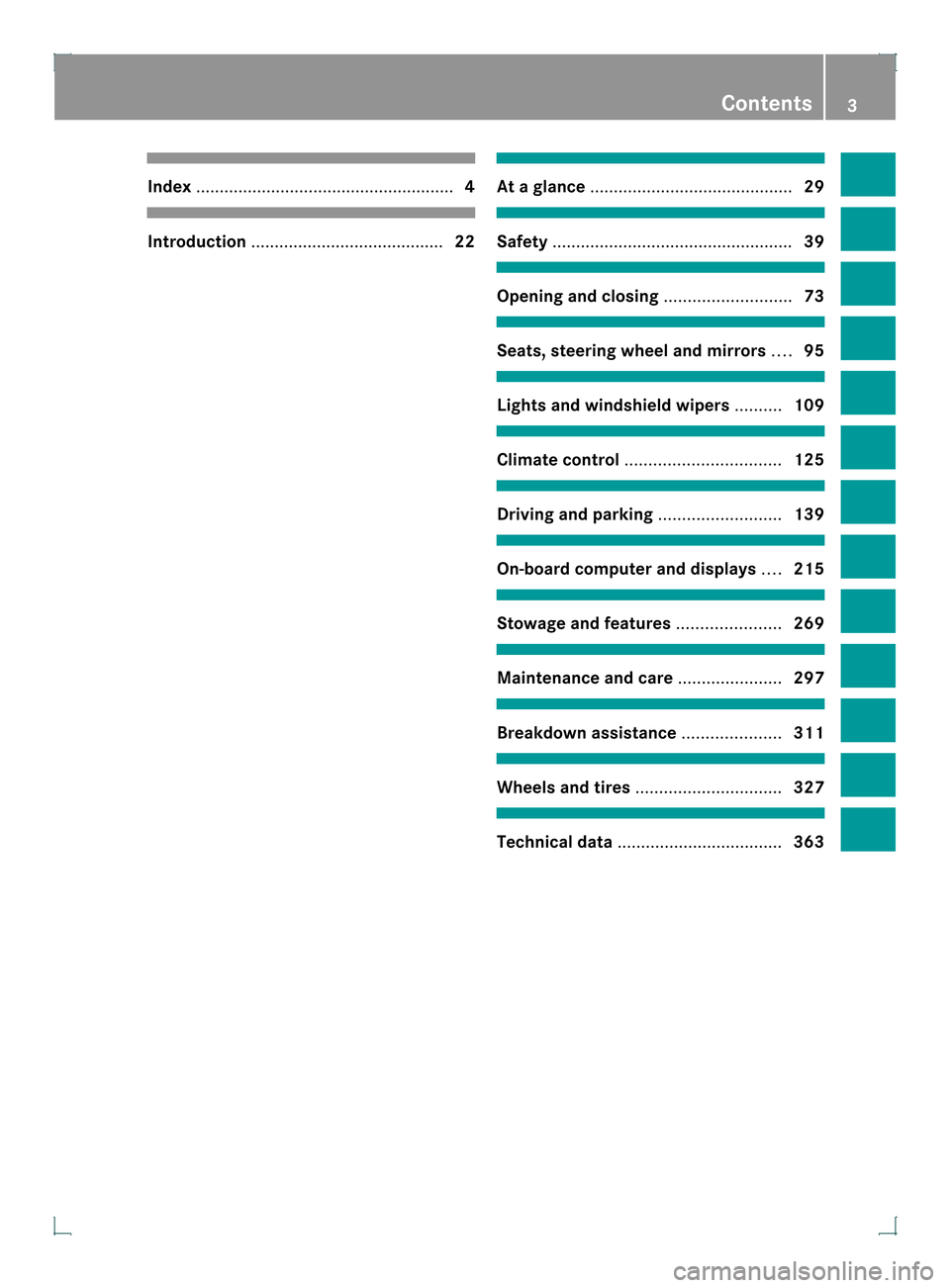
Index
....................................................... 4Introduction
......................................... 22 At
ag lance ........................................... 29 Safety
................................................... 39 Opening and closing
...........................73 Seats, steering wheel and mirrors
....95 Lights and windshield wipers
..........109 Climate control
................................. 125 Driving and parking
..........................139 On-board computer and displays
....215 Stowage and features
......................269 Maintenance and care
......................297 Breakdown assistance
.....................311 Wheels and tires
............................... 327 Technical data
................................... 363 Contents
3
Page 10 of 378
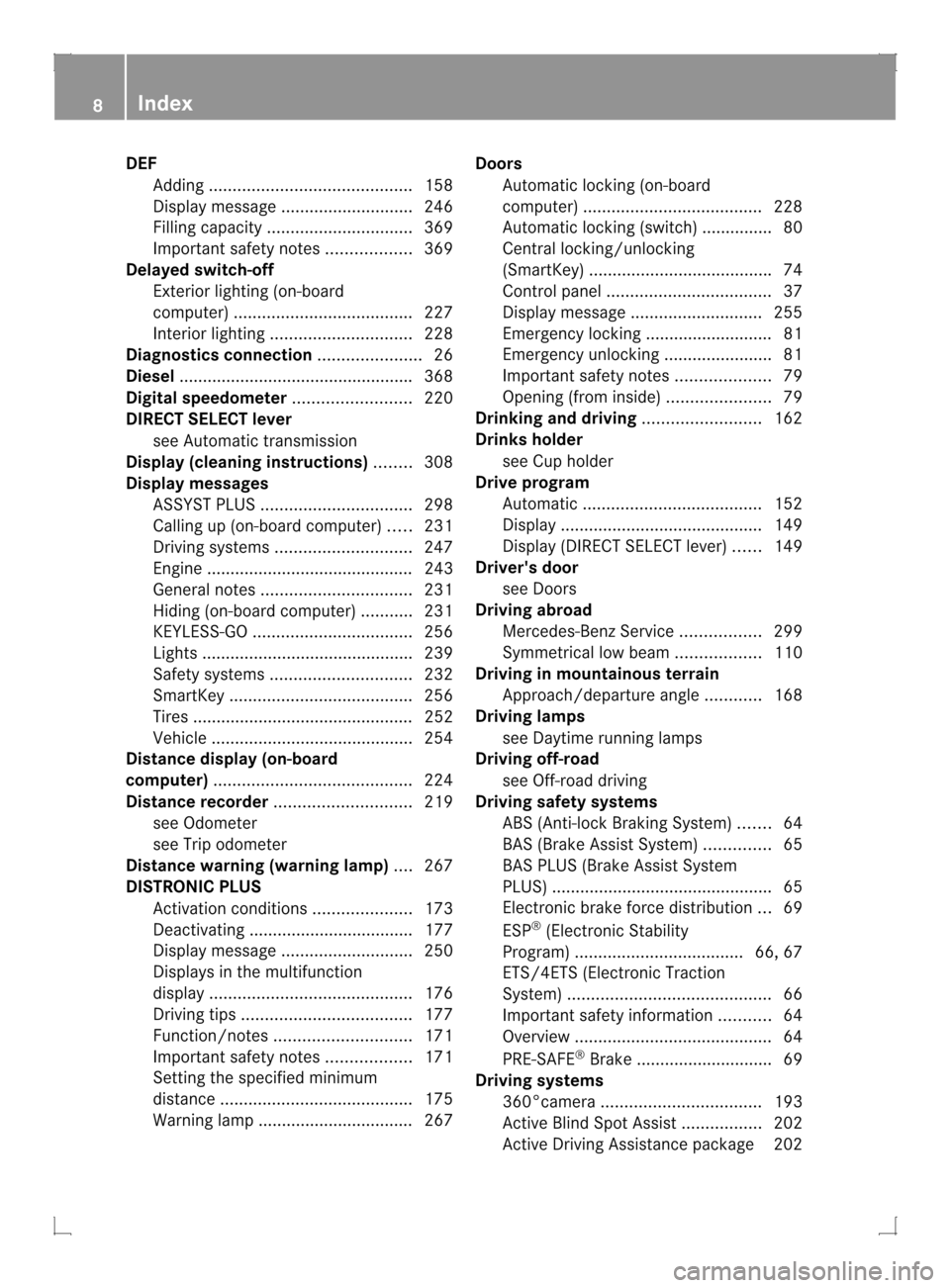
DEF
Addin g........................................... 158
Display message ............................ 246
Filling capacity ............................... 369
Important safety notes ..................369
Delaye dswitch-off
Exterio rlighting (on-board
computer )...................................... 227
Interior lighting .............................. 228
Diagnostics connection ......................26
Diesel ................................................. .368
Digital speedometer .........................220
DIREC TSELECT lever
see Automatic transmission
Display (cleaning instructions) ........308
Display messages ASSYST PLUS ................................ 298
Calling up (on-board computer) .....231
Driving systems ............................. 247
Engine ............................................ 243
General notes ................................ 231
Hiding (on-board computer) ...........231
KEYLESS-GO .................................. 256
Lights ............................................ .239
Safety systems .............................. 232
SmartKey ....................................... 256
Tires ............................................... 252
Vehicle .......................................... .254
Distance display (on-board
computer) .......................................... 224
Distance recorder ............................. 219
see Odometer
see Trip odometer
Distance warning (warning lamp) ....267
DISTRONIC PLUS Activatio ncondition s..................... 173
Deactivating ................................... 177
Display message ............................ 250
Displays in the multifunction
displa y........................................... 176
Driving tips .................................... 177
Function/notes ............................. 171
Important safety notes ..................171
Setting the specified minimum
distance ......................................... 175
Warning lamp ................................. 267 Doors
Automatic locking (on-board
computer) ...................................... 228
Automatic locking (switch) .............. .80
Central locking/unlocking
(SmartKey) ...................................... .74
Control panel ................................... 37
Display message ............................ 255
Emergency locking ........................... 81
Emergency unlocking .......................81
Important safety notes ....................79
Opening (from inside) ......................79
Drinking and driving .........................162
Drinks holder see Cuph older
Drive program
Automatic ...................................... 152
Display ........................................... 149
Display (DIRECT SELECT lever) ......149
Driver's door
see Doors
Driving abroad
Mercedes-Benz Service .................299
Symmetrical low bea m.................. 110
Driving in mountainous terrain
Approach/departure angl e............ 168
Driving lamps
see Daytime running lamps
Driving off-road
see Off-road driving
Driving safety systems
ABS (Anti-lock Braking System) .......64
BAS (Brake Assist System) ..............65
BAS PLUS (Brake Assist System
PLUS) .............................................. .65
Electroni cbrake force distribution ...69
ESP ®
(Electronic Stability
Program) .................................... 66, 67
ETS/4ETS (Electronic Traction
System) ........................................... 66
Important safety information ...........64
Overview .......................................... 64
PRE-SAFE ®
Brake ............................ .69
Driving systems
360°camera .................................. 193
Active Blind Spot Assist .................202
Active Driving Assistance package 202 8
Index
Page 15 of 378
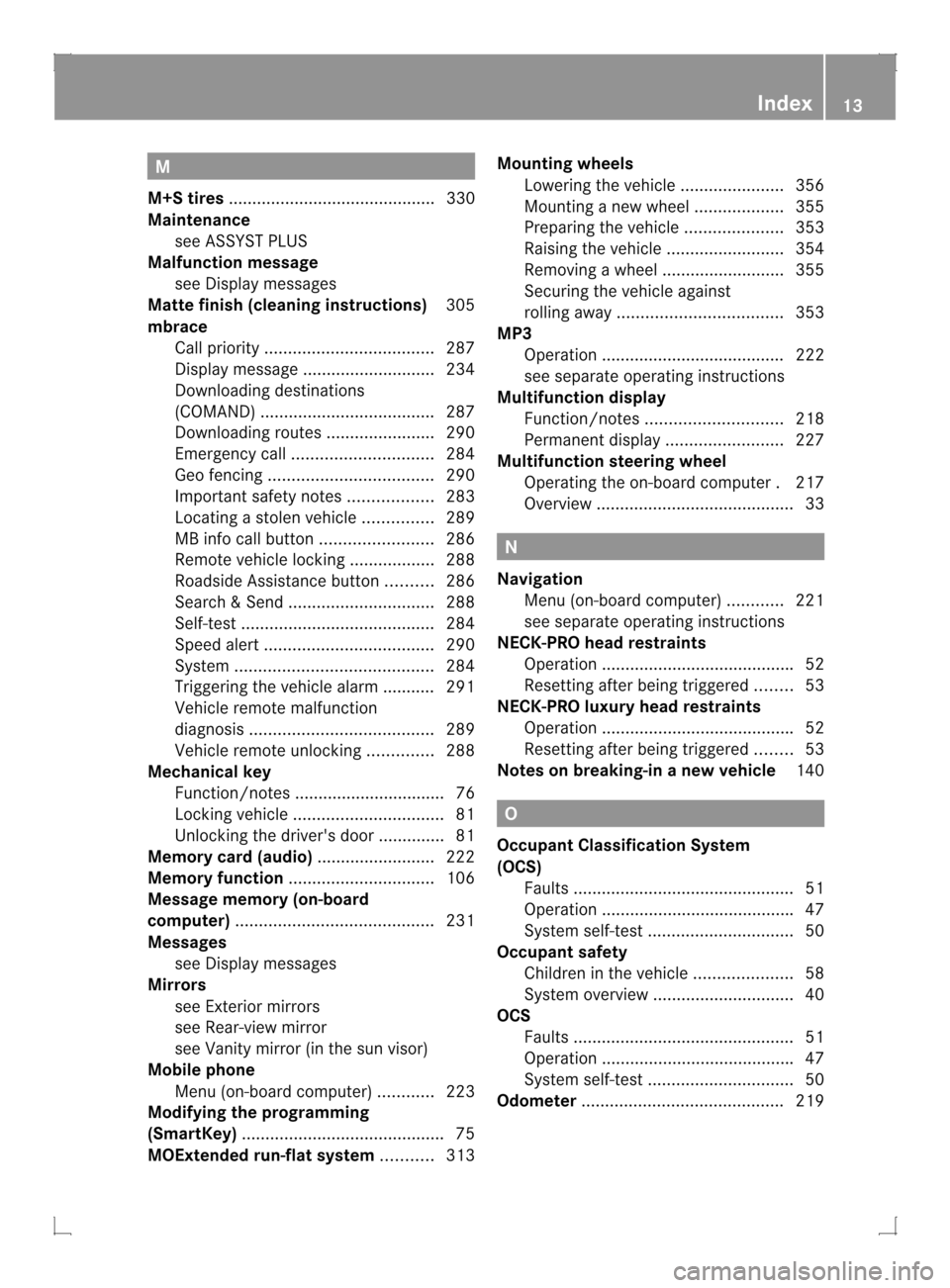
M
M+S tires ............................................ 330
Maintenance see ASSYST PLUS
Malfunction message
see Display messages
Matte finish (cleaning instructions) 305
mbrace Call priority .................................... 287
Display message ............................ 234
Downloading destinations
(COMAND) ..................................... 287
Downloading route s....................... 290
Emergency call .............................. 284
Geo fencing ................................... 290
Important safety notes ..................283
Locating astolen vehicl e............... 289
MB info call button ........................286
Remote vehicle locking ..................288
Roadside Assistance button ..........286
Search &Send ............................... 288
Self-test ......................................... 284
Speed alert .................................... 290
System .......................................... 284
Triggering the vehicle alarm ........... 291
Vehicle remote malfunction
diagnosi s....................................... 289
Vehicle remote unlocking ..............288
Mechanical key
Function/notes ................................ 76
Locking vehicle ................................ 81
Unlocking the driver's door ..............81
Memory card (audio) .........................222
Memory function ............................... 106
Message memory (on-board
computer) .......................................... 231
Messages see Display messages
Mirrors
see Exterior mirrors
see Rear-view mirror
see Vanity mirror (in the sun visor)
Mobile phone
Menu (on-board computer) ............223
Modifying the programming
(SmartKey) ........................................... 75
MOExtended run-flat system ...........313Mounting wheels
Lowering the vehicle ......................356
Mounting anew wheel ................... 355
Preparing the vehicle .....................353
Raising the vehicle .........................354
Removing awheel .......................... 355
Securing the vehicle against
rolling away ................................... 353
MP3
Operation ....................................... 222
see separate operating instructions
Multifunction display
Function/notes ............................. 218
Permanent displa y......................... 227
Multifunction steering wheel
Operating the on-board computer .217
Overview .......................................... 33 N
Navigation Menu (on-board computer) ............221
see separate operating instructions
NECK-PRO head restraints
Operation ........................................ .52
Resetting after being triggered ........53
NECK-PRO luxury head restraints
Operation ........................................ .52
Resetting after being triggered ........53
Notes on breaking-in anew vehicle 140 O
Occupant Classification System
(OCS) Fault s............................................... 51
Operation ........................................ .47
System self-test ............................... 50
Occupant safety
Childre ninthe vehicle ..................... 58
System overview .............................. 40
OCS
Faults ............................................... 51
Operation ........................................ .47
System self-test ............................... 50
Odometer ........................................... 219 Index
13
Page 19 of 378
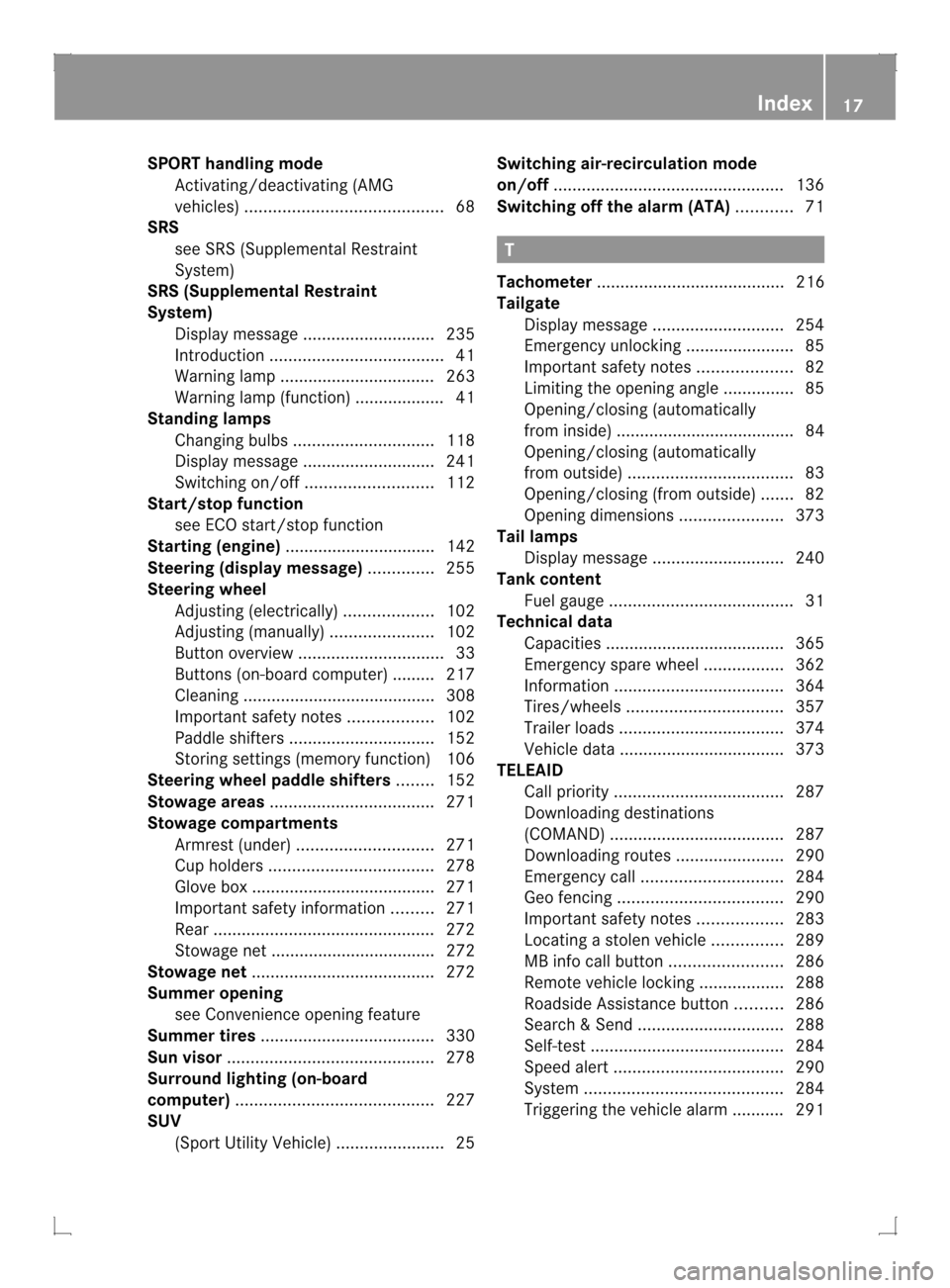
SPORT handling mode
Activating/deactivating (AMG
vehicles) .......................................... 68
SRS
see SRS (Supplemental Restraint
System)
SRS (Supplemental Restraint
System)
Display message ............................ 235
Introduction ..................................... 41
Warning lamp ................................. 263
Warning lamp (function) ................... 41
Standing lamps
Changing bulbs .............................. 118
Display message ............................ 241
Switching on/off ........................... 112
Start/stop function
see ECO start/stop function
Starting (engine) ................................ 142
Steering (display message) ..............255
Steering wheel Adjusting (electrically). ..................102
Adjusting (manually). .....................102
Button overview ............................... 33
Buttons (on-board computer) ......... 217
Cleaning ......................................... 308
Important safety notes ..................102
Paddle shifters ............................... 152
Storing settings (memory function) 106
Steering wheel paddle shifters ........152
Stowage areas ................................... 271
Stowage compartments Armrest (under) ............................. 271
Cuph olders ................................... 278
Glove box ...................................... .271
Important safety information .........271
Rea r............................................... 272
Stowage net ................................... 272
Stowage net ....................................... 272
Summer opening see Convenience opening feature
Summer tires ..................................... 330
Sun visor ............................................ 278
Surround lighting (on-board
computer) .......................................... 227
SUV (Sport Utility Vehicle) .......................25Switching air-recirculation mode
on/off
................................................. 136
Switching off the alarm (ATA) ............71 T
Tachometer ........................................ 216
Tailgate Display message ............................ 254
Emergency unlocking .......................85
Important safety notes ....................82
Limiting the opening angle ...............85
Opening/closing (automatically
from inside) ...................................... 84
Opening/closing (automatically
from outside) ................................... 83
Opening/closing (from outside) .......82
Opening dimensions ......................373
Tail lamps
Display message ............................ 240
Tank content
Fuel gauge ....................................... 31
Technical data
Capacities ...................................... 365
Emergency spare wheel .................362
Information .................................... 364
Tires/wheels ................................. 357
Trailer loads ................................... 374
Vehicle data ................................... 373
TELEAID
Call priority .................................... 287
Downloading destinations
(COMAND) ..................................... 287
Downloading route s....................... 290
Emergency call .............................. 284
Geo fencing ................................... 290
Important safety notes ..................283
Locating astolen vehicl e............... 289
MB info call button ........................286
Remote vehicle locking ..................288
Roadside Assistance button ..........286
Search &Send ............................... 288
Self-test ......................................... 284
Speed alert .................................... 290
System .......................................... 284
Triggering the vehicle alarm ........... 291 Index
17
Page 20 of 378
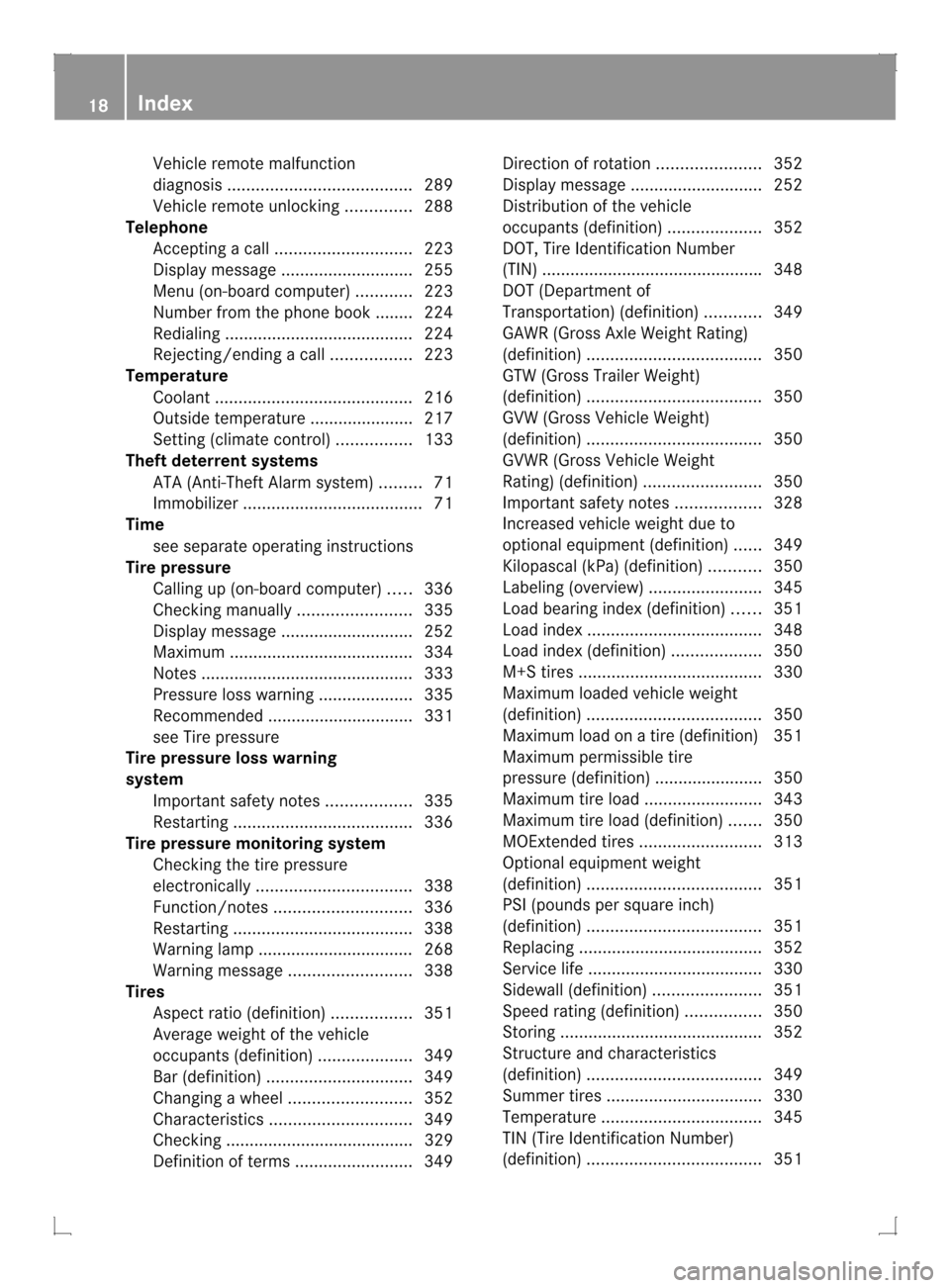
Vehicle remote malfunction
diagnosis
....................................... 289
Vehicle remote unlocking ..............288
Telephone
Accepting acall............................. 223
Display message ............................ 255
Menu (on-board computer) ............223
Number from the phone book ....... .224
Redialing ........................................ 224
Rejecting/ending acall................. 223
Temperature
Coolant .......................................... 216
Outside temperature ..................... .217
Setting (climate control) ................133
Theft deterrent systems
ATA (Anti-Theft Alarm system) .........71
Immobilize r...................................... 71
Time
see separate operating instructions
Tire pressure
Calling up (on-board computer) .....336
Checking manually ........................335
Display message ............................ 252
Maximum ....................................... 334
Notes ............................................. 333
Pressure loss warning ....................335
Recommended ............................... 331
see Tire pressure
Tire pressure loss warning
system
Important safety notes ..................335
Restarting ...................................... 336
Tire pressure monitoring system
Checking the tire pressure
electronically ................................. 338
Function/notes ............................. 336
Restarting ...................................... 338
Warning lamp ................................. 268
Warning message .......................... 338
Tires
Aspect ratio (definition) .................351
Average weight of the vehicle
occupants (definition) ....................349
Bar (definition) ............................... 349
Changing awheel .......................... 352
Characteristics .............................. 349
Checking ........................................ 329
Definition of terms .........................349Direction of rotatio
n...................... 352
Display message ............................ 252
Distributio nofthe vehicle
occupants (definition) ....................352
DOT, Tire Identification Number
(TIN) .............................................. .348
DOT (Department of
Transportation) (definition) ............349
GAWR (Gross Axle Weight Rating)
(definition) ..................................... 350
GTW (Gross Trailer Weight)
(definition) ..................................... 350
GVW (Gross Vehicle Weight)
(definition) ..................................... 350
GVWR (Gross Vehicle Weight
Rating) (definition) .........................350
Important safety notes ..................328
Increased vehicle weight due to
optional equipment (definition) ......349
Kilopascal (kPa) (definition) ...........350
Labeling (overview )........................ 345
Load bearing index (definition) ......351
Load index ..................................... 348
Load index (definition) ...................350
M+S tires ....................................... 330
Maximum loaded vehicle weight
(definition) ..................................... 350
Maximum load on a tire (definition) 351
Maximum permissible tire
pressure (definition) ....................... 350
Maximum tire loa d......................... 343
Maximum tire load (definition) .......350
MOExtended tires ..........................313
Optional equipment weight
(definition) ..................................... 351
PSI (pounds per square inch)
(definition) ..................................... 351
Replacing ....................................... 352
Service life ..................................... 330
Sidewall (definition) .......................351
Speed rating (definition) ................350
Storing ........................................... 352
Structure and characteristics
(definition) ..................................... 349
Summer tires ................................. 330
Temperature .................................. 345
TIN (Tire Identification Number)
(definition) ..................................... 35118
Index
Page 23 of 378
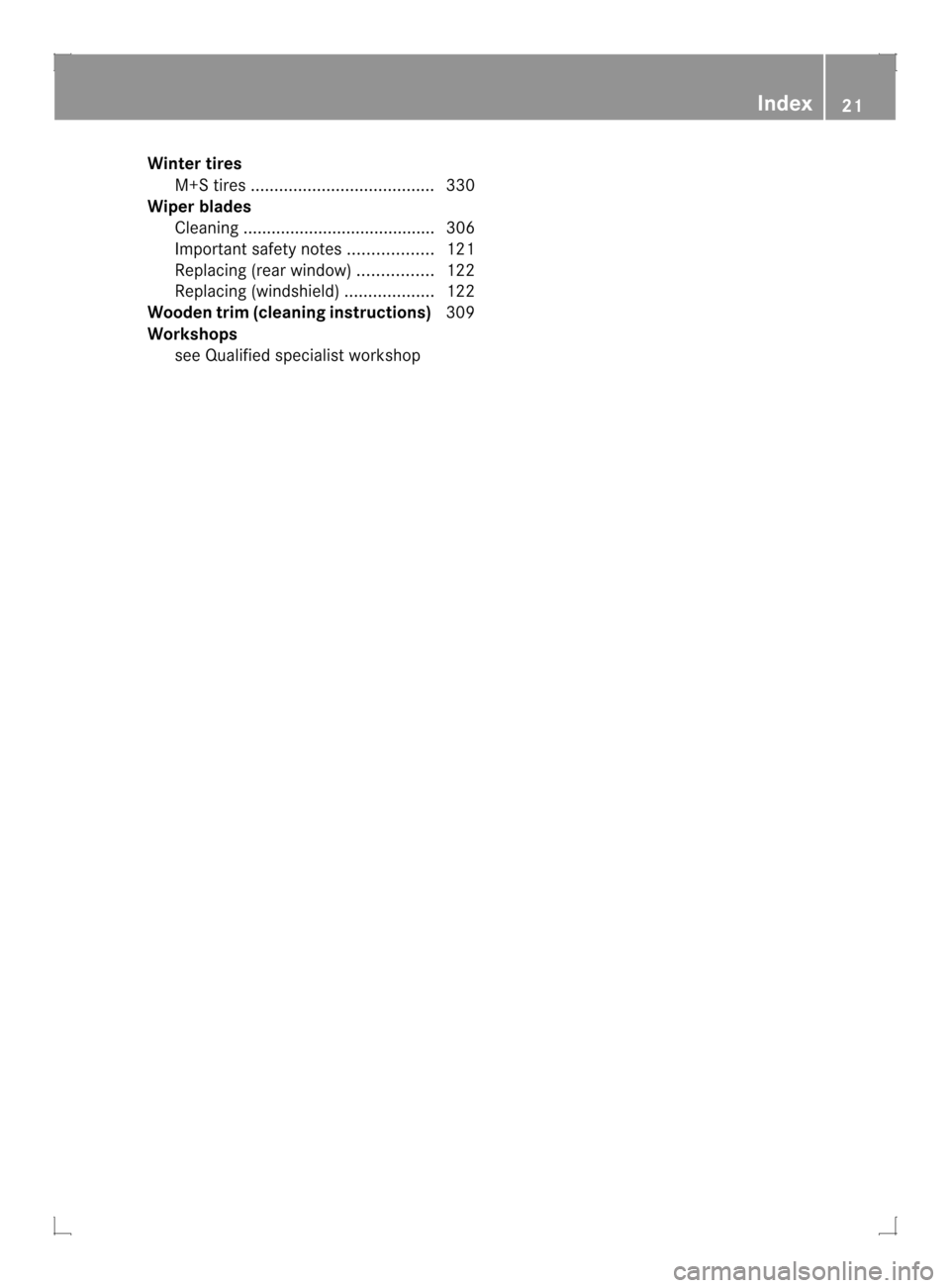
Winter tires
M+S tires ....................................... 330
Wiper blades
Cleaning ......................................... 306
Important safety notes ..................121
Replacing (rea rwindow) ................ 122
Replacing (windshield )................... 122
Wooden trim (cleaning instructions) 309
Workshops see Qualified specialist workshop Index
21
Page 25 of 378
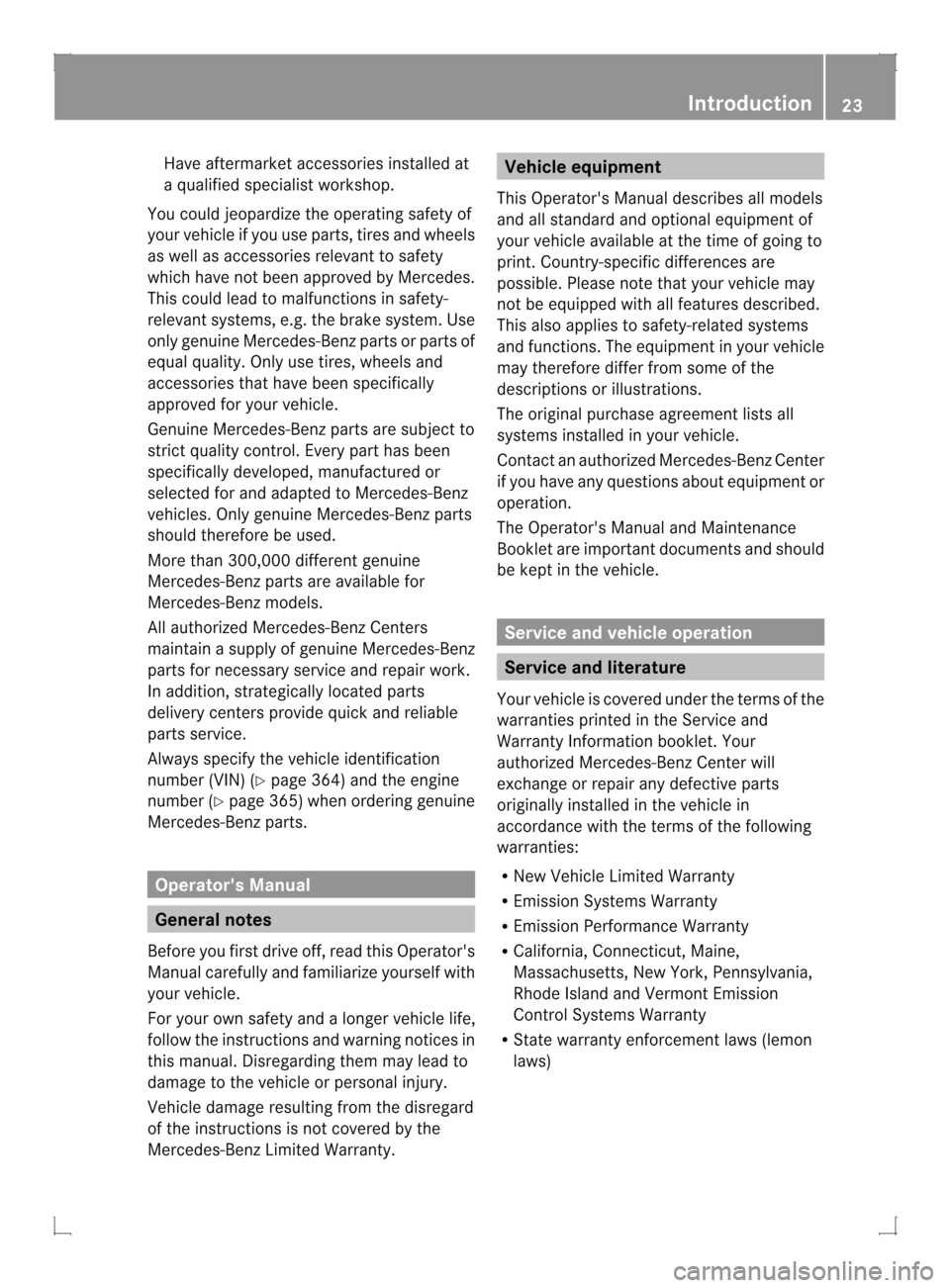
Have aftermarke
taccessories installed at
a qualified specialist workshop.
You could jeopardize the operating safety of
your vehicle if you use parts, tires and wheels
as well as accessories relevant to safety
which have not bee napproved by Mercedes.
This could lead to malfunctions in safety-
relevant systems, e.g. the brake system .Use
only genuine Mercedes-Benz parts or parts of
equal quality. Only use tires, wheels and
accessories that have been specifically
approved for your vehicle.
Genuine Mercedes-Benz parts are subject to
strict quality control. Every part has been
specifically developed, manufactured or
selected for and adapted to Mercedes-Benz
vehicles. Only genuine Mercedes-Benz parts
should therefore be used.
More than 300,000 different genuine
Mercedes-Benz parts are available for
Mercedes-Benz models.
All authorized Mercedes-Benz Centers
maintain a supply of genuine Mercedes-Benz
parts for necessary service and repair work.
In addition, strategically located parts
delivery centers provide quick and reliable
parts service.
Always specify the vehicle identification
number (VIN) (Y page 364) and the engine
number (Y page 365) when ordering genuine
Mercedes-Benz parts. Operator's Manual
General notes
Before you first drive off, read this Operator's
Manual carefully and familiarize yourselfw ith
your vehicle.
For your own safety and a longer vehicle life,
follow the instructions and warning notices in
this manual. Disregarding the mmay lead to
damage to the vehicle or personal injury.
Vehicle damage resulting from the disregard
of the instructions is not covered by the
Mercedes-Ben zLimited Warranty. Vehicle equipment
This Operator's Manual describes all models
and all standard and optional equipmen tof
your vehicle available at th etime of going to
print. Country-specific differences are
possible .Please note that your vehicle may
not be equipped with all features described.
This also applies to safety-related systems
and functions .The equipment in your vehicle
may therefore differ from some of the
descriptions or illustrations.
The original purchase agreement lists all
systems installed in your vehicle.
Contact an authorized Mercedes-Ben zCenter
if you have any questions about equipment or
operation.
The Operator's Manual and Maintenance
Booklet are important documents and should
be kept in the vehicle. Service and vehicle operation
Service and literature
Your vehicle is covered under the terms of the
warranties printed in the Service and
Warranty Information booklet. Your
authorized Mercedes-BenzC enter will
exchange or repair any defective parts
originally installed in the vehicle in
accordance with the term softhe following
warranties:
R New Vehicle Limited Warranty
R Emission Systems Warranty
R Emission Performance Warranty
R California, Connecticut, Maine,
Massachusetts, New York, Pennsylvania,
Rhode Island and Vermont Emission
Control Systems Warranty
R State warranty enforcement laws (lemon
laws) Introduction
23 Z
Page 28 of 378
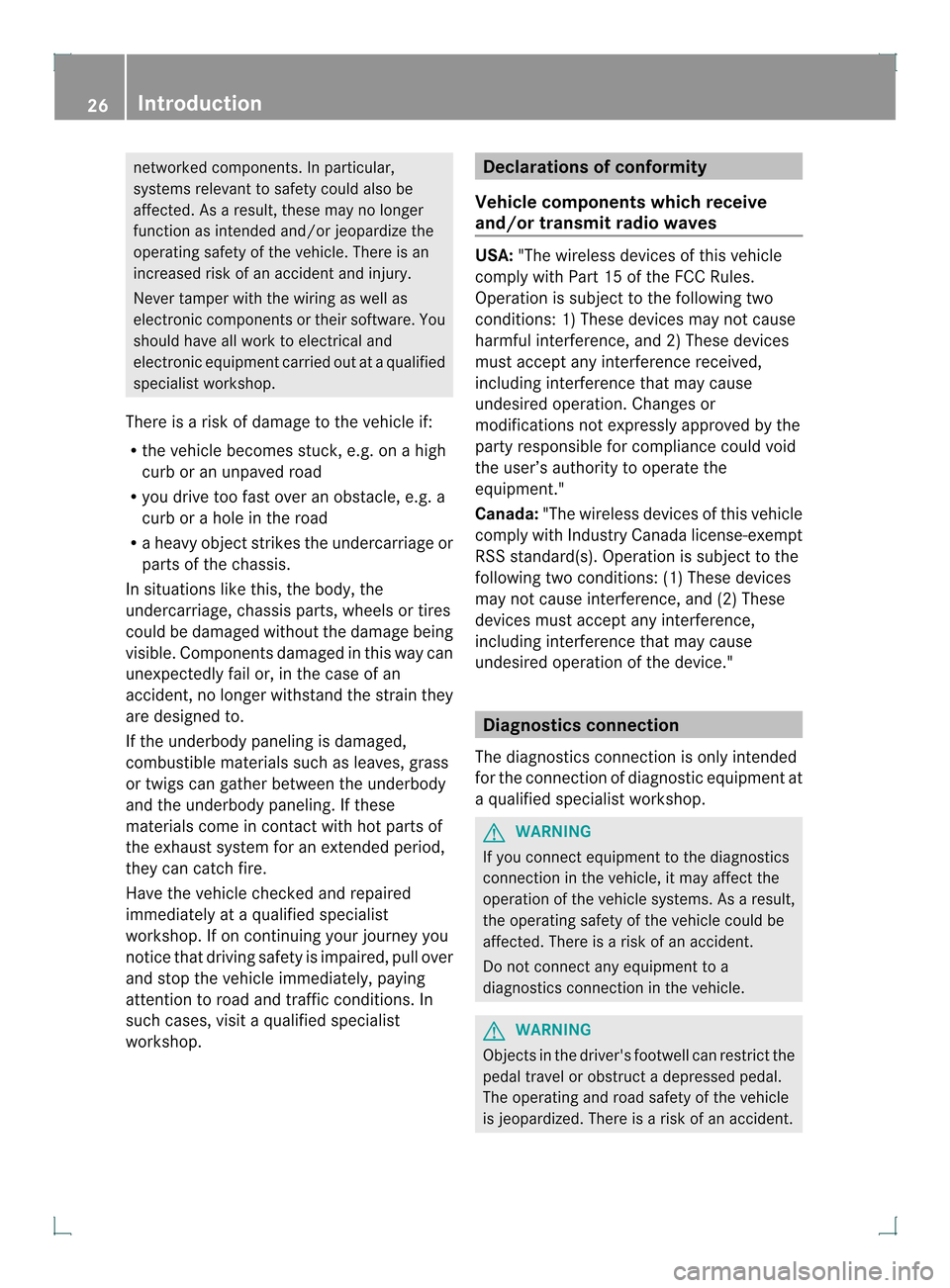
networked components. In particular,
systems relevant to safety could also be
affected. As a result, these may no longer
functio nas intended and/or jeopardize the
operating safety of the vehicle. There is an
increased risk of an accident and injury.
Never tamper with the wiring as well as
electronic components or their software. You
should have all work to electrical and
electronic equipment carried out at a qualified
specialist workshop.
There is a risk of damage to the vehicle if:
R the vehicle becomes stuck, e.g. on a high
curb or an unpaved road
R you drive too fast over an obstacle, e.g. a
curb or a hole in the road
R a heavy object strikes the undercarriage or
parts of the chassis.
In situations like this, the body, the
undercarriage, chassis parts, wheels or tires
could be damaged without the damage being
visible. Components damaged in this way can
unexpectedly fail or, in the case of an
accident, no longer withstand the strain they
are designed to.
If the underbody paneling is damaged,
combustible materials such as leaves, grass
or twigs can gather between the underbody
and the underbody paneling. If these
materials come in contact with hot parts of
the exhaust system for an extended period,
they can catch fire.
Have the vehicle checked and repaired
immediately at a qualified specialist
workshop. If on continuing your journey you
notice that driving safety is impaired, pull over
and stop the vehicle immediately, paying
attention to road and traffic conditions. In
such cases, visit a qualified specialist
workshop. Declarations of conformity
Vehicle components which receive
and/or transmit radio waves USA:
"The wireless devices of this vehicle
comply with Part 15 of the FCC Rules.
Operation is subject to the following two
conditions: 1) These devices may not cause
harmful interference, and 2) These devices
must accept any interference received,
including interference that may cause
undesired operation. Changes or
modifications not expressly approved by the
party responsible for compliance could void
the user’s authority to operate the
equipment."
Canada: "The wireless devices of this vehicle
comply with Industry Canada license-exempt
RSS standard(s). Operation is subject to the
following two conditions: (1) These devices
may not cause interference, and (2) These
devices must accept any interference,
including interference that may cause
undesired operation of the device." Diagnostics connection
The diagnostics connection is only intended
for the connection of diagnostic equipment at
a qualified specialist workshop. G
WARNING
If you connect equipment to the diagnostics
connection in the vehicle, it may affect the
operation of the vehicle systems. As a result,
the operating safety of the vehicle could be
affected. There is a risk of an accident.
Do not connect any equipment to a
diagnostics connection in the vehicle. G
WARNING
Objects in the driver's footwell can restrict the
pedal travel or obstruct adepressed pedal.
The operating and road safety of the vehicle
is jeopardized. There is a risk of an accident. 26
Introduction
Page 66 of 378
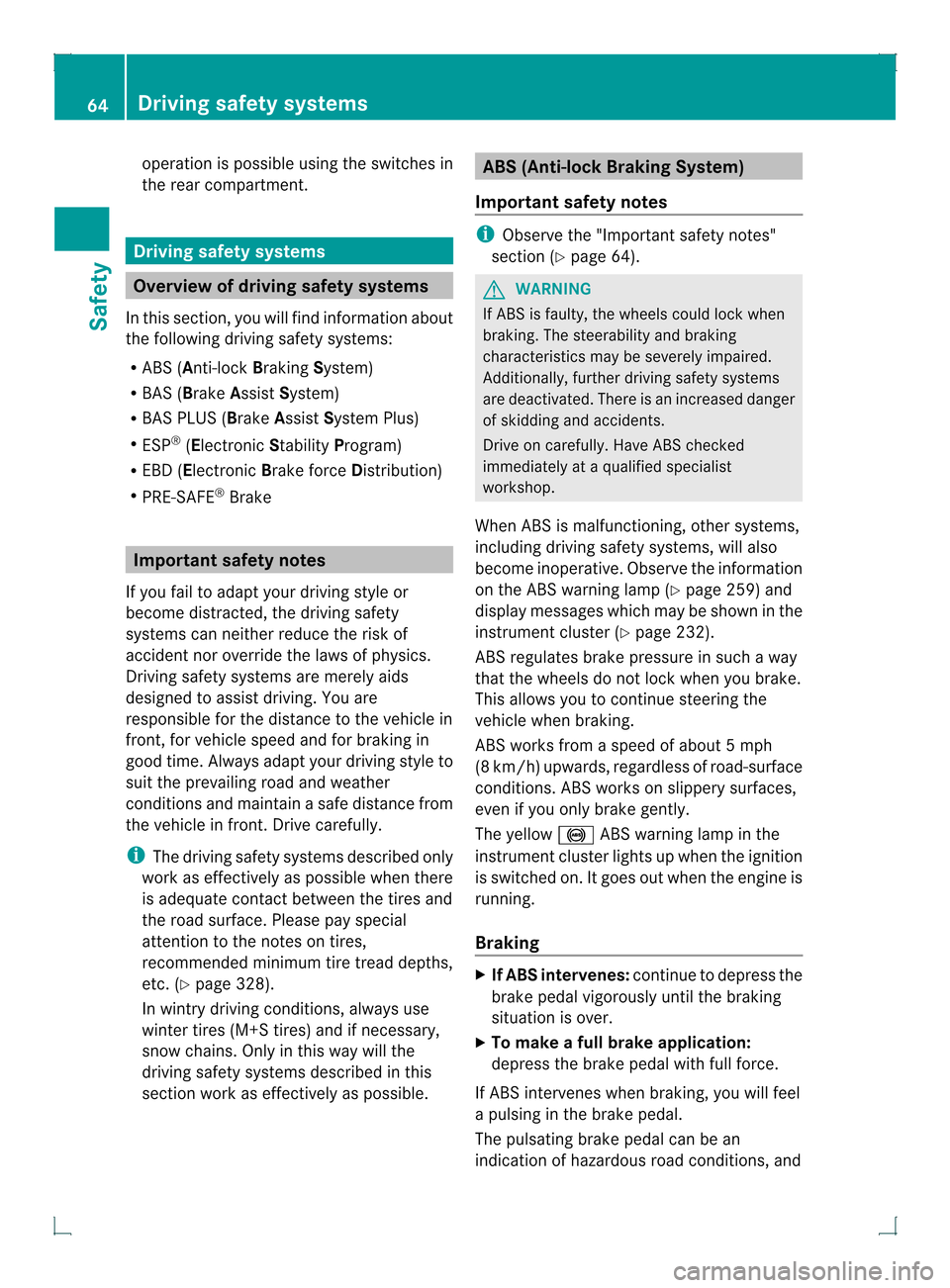
operation is possible using the switches in
the rear compartment.
Driving safety systems
Overview of driving safety systems
In this section, you will find information about
the following driving safety systems:
R ABS (Anti-lock BrakingSystem)
R BAS (Brake AssistSystem)
R BAS PLUS ( BrakeAssist System Plus)
R ESP ®
(Electronic StabilityProgram)
R EBD ( Electronic Brake force Distribution)
R PRE-SAFE ®
Brake Important safety notes
If you fail to adapt your driving style or
become distracted, the driving safety
systems can neither reduce the risk of
accident nor override the laws of physics.
Driving safety systems are merely aids
designed to assist driving. You are
responsible for the distance to the vehicle in
front, for vehicle speed and for braking in
good time. Always adapt your driving style to
suit the prevailing road and weather
conditions and maintain asafe distance from
the vehicle in front. Drive carefully.
i The driving safety systems described only
work as effectively as possible when there
is adequate contact between the tires and
the road surface. Please pay special
attention to the note son tires,
recommended minimu mtire tread depths,
etc. (Y page 328).
In wintry driving conditions, always use
winter tires (M+S tires) and if necessary,
snow chains. Only in this way will the
driving safety systems described in this
section work as effectively as possible. ABS (Anti-lock Braking System)
Important safety notes i
Observe the "Importan tsafety notes"
sectio n(Ypage 64). G
WARNING
If ABSi s faulty, the wheels could lock when
braking. The steerability and braking
characteristics may be severely impaired.
Additionally, further driving safety systems
are deactivated. There is an increased danger
of skidding and accidents.
Drive on carefully. Have ABS checked
immediately at a qualified specialist
workshop.
When ABS is malfunctioning, other systems,
including driving safety systems, will also
become inoperative. Observe the information
on the ABS warning lamp (Y page 259) and
display messages which may be shown in the
instrument cluster (Y page 232).
ABS regulates brake pressure in such a way
that the wheels do not lock when you brake.
This allows you to continue steering the
vehicle when braking.
ABS works from a speed of about 5 mph
(8 km/h) upwards, regardless of road-surface
conditions. ABS works on slippery surfaces,
even if you only brake gently.
The yellow 001AABS warning lamp in the
instrument cluster lights up when the ignition
is switched on. It goes out when the engine is
running.
Braking X
If ABS intervenes: continue to depress the
brake pedal vigorously until the braking
situation is over.
X To make a full brake application:
depress the brake pedal with full force.
If ABS intervenes when braking, you will feel
a pulsing in the brake pedal.
The pulsating brake pedal can be an
indication of hazardous road conditions, and 64
Driving safety systemsSafety
Page 68 of 378
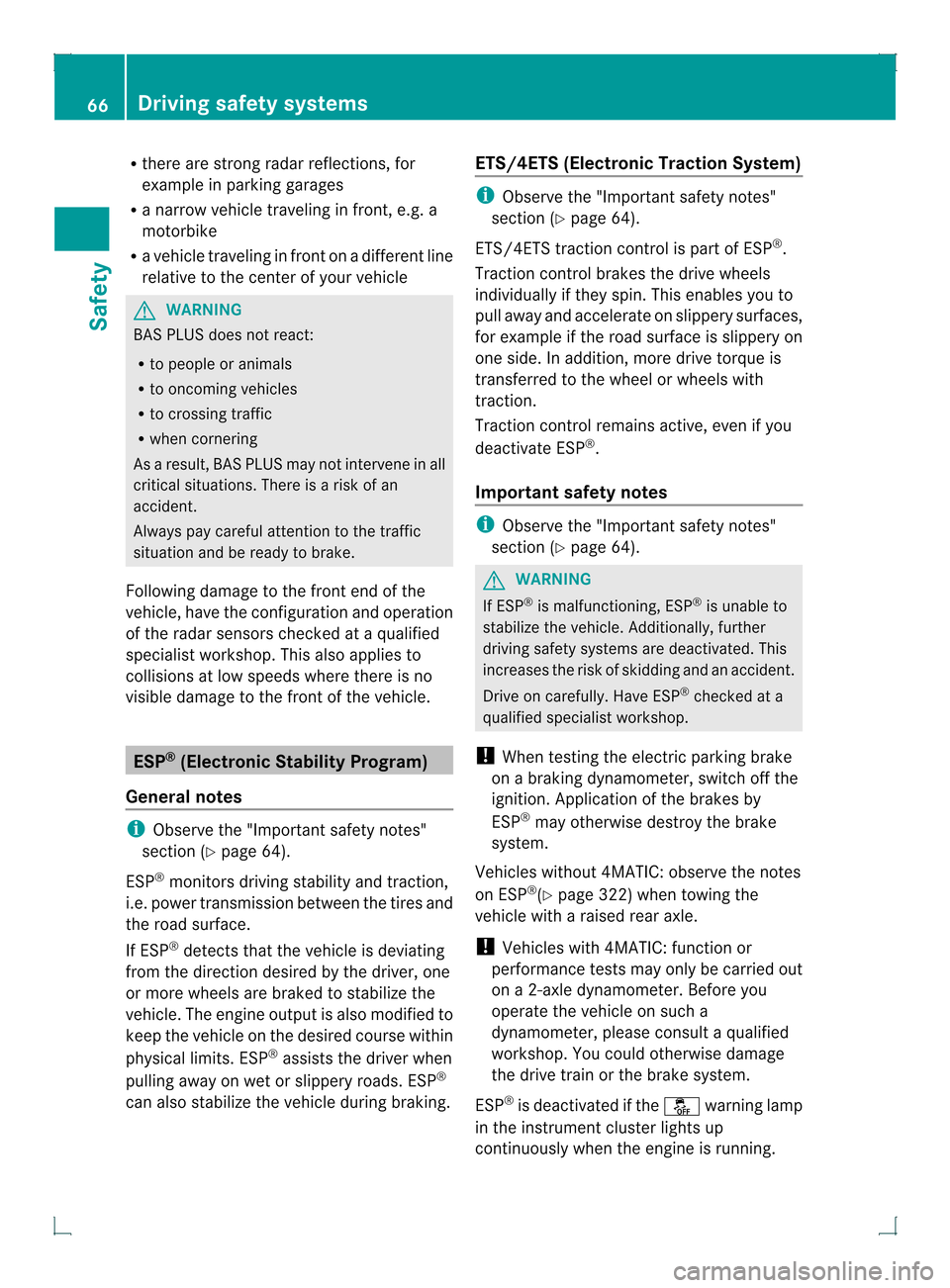
R
there are strong rada rreflections, for
example in parking garages
R a narrow vehicle traveling in front, e.g. a
motorbike
R a vehicle traveling in fron tonadifferent line
relative to the center of your vehicle G
WARNING
BAS PLUS does not react:
R to people or animals
R to oncoming vehicles
R to crossing traffic
R when cornering
As aresult, BAS PLUS may not intervene in all
critical situations. There is a risk of an
accident.
Always pay careful attention to the traffic
situation and be ready to brake.
Following damage to the fron tend of the
vehicle, have the configuratio nand operation
of the rada rsensors checked at a qualified
specialist workshop. This also applies to
collisions at low speeds where there is no
visible damage to the fron tofthe vehicle. ESP
®
(Electronic Stability Program)
General notes i
Observe the "Important safety notes"
section (Y page 64).
ESP ®
monitors driving stability and traction,
i.e. power transmission between the tires and
the road surface.
If ESP ®
detects that the vehicle is deviating
from the direction desired by the driver, one
or more wheels are braked to stabilize the
vehicle. The engine output is also modified to
keep the vehicle on the desired course within
physical limits. ESP ®
assists the driver when
pulling away on wet or slippery roads. ESP ®
can also stabilize the vehicle during braking. ETS/4ETS (Electronic Traction System) i
Observe the "Important safety notes"
section (Y page 64).
ETS/4ETS traction control is part of ESP ®
.
Traction control brakes the drive wheels
individually if they spin. This enables you to
pull away and accelerate on slippery surfaces,
for example if the road surface is slippery on
one side. In addition, more drive torque is
transferred to the wheel or wheels with
traction.
Traction control remains active, even if you
deactivate ESP ®
.
Important safety notes i
Observe the "Important safety notes"
section (Y page 64). G
WARNING
If ESP ®
is malfunctioning, ESP ®
is unable to
stabilize the vehicle. Additionally, further
driving safety systems are deactivated. This
increases the risk of skidding and an accident.
Drive on carefully. Have ESP ®
checked at a
qualified specialist workshop.
! When testing the electric parking brake
on a braking dynamometer, switch off the
ignition. Application of the brakes by
ESP ®
may otherwise destroy the brake
system.
Vehicles without 4MATIC: observe the notes
on ESP ®
(Y page 322) when towing the
vehicle with a raised rear axle.
! Vehicles with 4MATIC: function or
performance tests may only be carried out
on a 2-axle dynamometer. Before you
operate the vehicle on such a
dynamometer, please consult a qualified
workshop. You could otherwise damage
the drive train or the brake system.
ESP ®
is deactivated if the 0017warning lamp
in the instrumentc luster lights up
continuously when the engine is running. 66
Driving safety systemsSafety